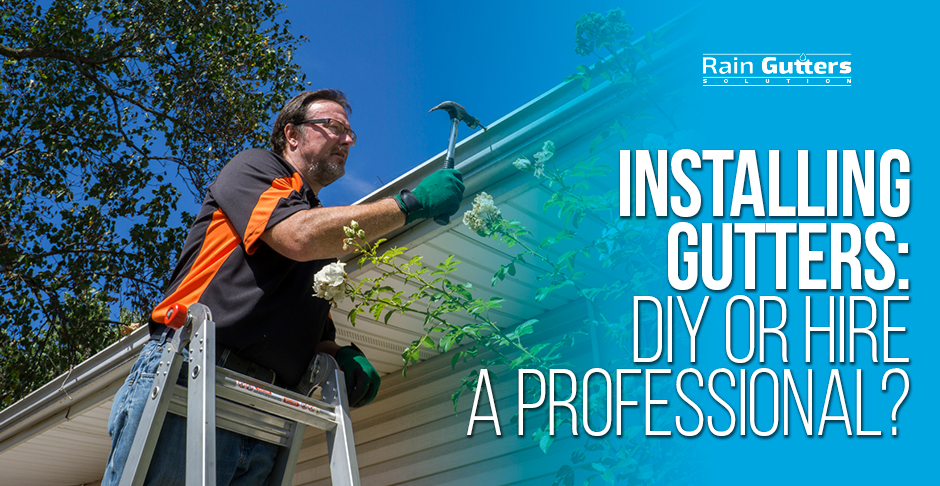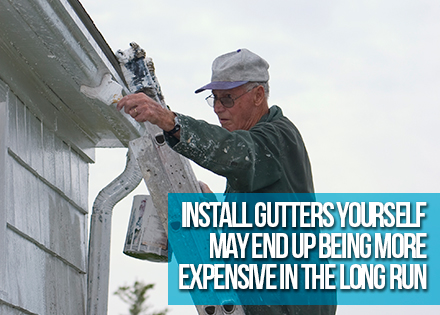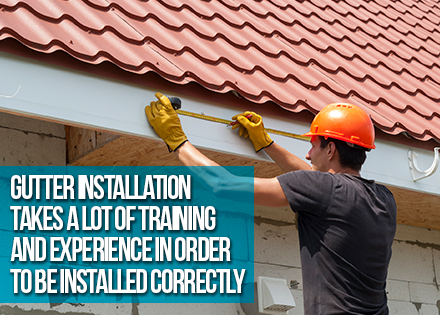Can You Install Gutters Yourself?
September 15, 2022

If you want your home to have a proper defense against water damage, a rain gutter is the answer. Rain gutters are currently a popular solution to protect the integrity of homes and businesses in South Florida.
Gutters and Downspouts Installers tailor their services to whatever the owners need for their property, ensuring the highest quality and long-lasting results. Despite all this, many people are used to applying DIY methods for their home improvement plans, which is where traditional/sectioned gutters come in as a fairly common practice among homeowners.
DIY Gutter Installation
You can install your gutters yourself, as long as you have the right tools and proper assistance. Gutter installation requires physical strength to juggle large metal pieces, and certain skill to work on top of a ladder. For this reason, we don't recommend doing the work without the assistance of at least one other person. You also need to define several measurements in advance, like your roof pitch and the length of the gutter run.

Here's an outline of how a safe DIY installation should look like, step by step. Keep in mind that we're focusing on sectioned gutters as the general recommendation is to let contractors manage the special equipment that's required for seamless gutters.
- Mark all the layout lines: Using chalk or a removable marker, you need to mark the high and low end of the gutter run on the fascia board (or the space below your roof shingles if you have a fascia-less house). Remember that the gutter slope should be between 1/4 and 1/2 of an inch for every ten feet of gutter run.
- Cut all the sections of the gutter: You can use tin snips or a hacksaw for this. You need to leave around 8 inches of overlap to affix the sections together later on.
- Fasten the gutter sections: Secure the sections on the ground to minimize your efforts while mounting the gutter below the roof. Hold the end caps in place, screw a 1/8 inch diameter hole, and install a rivet to attach the sections. You can also apply gutter sealant to keep the overlap in place.
- Attach hangers to the fascia: Drill the hangers so that they keep a 2 feet distance from each other.
- Install the gutter: Mount the gutter on the brackets and use a stainless steel machine screw to secure the guttering system to the fascia.
- Install gutter flashing: Slide the metal flashing between the gutter and the shingles to keep water from running behind the gutter.
- Attach gutter to the downspout: You need to trace the downspout's location on the low end of the gutter and drill a hole. Then, you can attach the outlet to the downspout elbow and, in turn, assemble the elbow to the downspout tube.
As you can probably guess, the installation requires multiple tools, including a cordless drill, a hacksaw, tin snips, a pop rivet gun, rivets or screws, tape measure, etc. To prevent accidents, you also need an extension ladder, a ladder stabilizer, protective gloves, and goggles.
What Happens if My Gutters Are Improperly Installed?
When comparing professional installations and DIY projects, it's more common for the latter to result in a faulty gutter. Part of a contractor's job involves understanding the building's structural limitations and having the best equipment to provide a personalized service.
It's possible to get the expected results when you install your gutters yourself, but you should still go into it knowing the consequences of a bad installation job.

If you make a miscalculation or assemble the gutters the wrong way, the guttering system, downspouts, and roof will be compromised. Misaligned gutters are a recurring problem with DIY installation, often leading to a full replacement job. In other cases, the gutter doesn't have the right dimensions to keep up with all the water during a storm, causing leaks and water splashing from the sides.
Also, if you see the gutters sagging away from the house, chances are that you've done a poor job fastening the gutter/hangers below the roof.
Why Hire a Professional Installer?
The main advantage people see in DIY projects comes with their low installation costs. It's true that you'll spend less money on your gutters when you install them yourself. You also have the freedom to choose the most flexible materials to work with if you're doing all the work without help.
Nevertheless, the assistance of an installation company will save you a lot of stress during the process and, more importantly, add countless long-term benefits to the end result. Some important things to consider:
- A custom gutter has more chances to last for decades without requiring major repairs. The contractor will take all environmental factors into account and provide the most durable materials. A professional installer is also less likely to make amateur mistakes while measuring your property and mounting the gutters.
- Seamless gutters also look better below your roof. A seasoned installation service will have multiple colors and materials available to ensure that your gutters don't clash with your home's layout.
- While a professional service is more expensive than a DIY installation, you'll save yourself many expenses down the line. Because custom gutters are more durable, you'll make fewer repairs along the years, and your home's fašade will also show less signs of wear and tear.
- The company will have a warranty in place to cover workmanship faults or property damage.
There are other factors that could be more advantageous depending on your circumstances. For example, if you don't have the best tool kit for an installation job, you'll still need to dedicate time and money to complete your equipment before installing the gutters yourself. If you've never participated in similar projects (gutter maintenance, roof repairs, etc.) working through all the steps can be very stressful. Some of the perks of hiring a professional come with a faster process and fewer worries on your end.
A professional contractor is also the best choice to replace damaged gutters since they know what areas to improve in your new gutters and won't risk property damage while dismounting the old guttering system. If you need additional downspouts to redirect all the water falling around your house, your installer can also help you identify the best placement for them, customizing your new gutters into the most effective drainage system.
Rain Gutters Solution provides the most reliable services when it comes to gutter installation and replacement. We save you the trouble of going through the installation on your own, using the best equipment to simplify the most taxing parts of the process. You can always call
(305) 270-7779 or fill out our website's
contact form to schedule an appointment with our specialists. And don't forget to subscribe to our
newsletter to get the latest news and tips straight to your inbox.
If you found this article helpful then let us know in the comments section below. Likewise, feel free to share it using the share options below. Want us to cover another topic of your interest pertaining to rain gutters? If so, then like us and follow us on social media, and post to any of our social media profiles the topic you'd like us to discuss:
Facebook @RainGuttersSolution,
Twitter @Gutterssolution and
Instagram @RainGuttersSolution

 Here's an outline of how a safe DIY installation should look like, step by step. Keep in mind that we're focusing on sectioned gutters as the general recommendation is to let contractors manage the special equipment that's required for seamless gutters.
Here's an outline of how a safe DIY installation should look like, step by step. Keep in mind that we're focusing on sectioned gutters as the general recommendation is to let contractors manage the special equipment that's required for seamless gutters. If you make a miscalculation or assemble the gutters the wrong way, the guttering system, downspouts, and roof will be compromised. Misaligned gutters are a recurring problem with DIY installation, often leading to a full replacement job. In other cases, the gutter doesn't have the right dimensions to keep up with all the water during a storm, causing leaks and water splashing from the sides.
If you make a miscalculation or assemble the gutters the wrong way, the guttering system, downspouts, and roof will be compromised. Misaligned gutters are a recurring problem with DIY installation, often leading to a full replacement job. In other cases, the gutter doesn't have the right dimensions to keep up with all the water during a storm, causing leaks and water splashing from the sides.